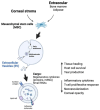Regenerative Therapy for Corneal Scarring Disorders
- PMID: 38540264
- PMCID: PMC10967722
- DOI: 10.3390/biomedicines12030649
Regenerative Therapy for Corneal Scarring Disorders
Abstract
The cornea is a transparent and vitally multifaceted component of the eye, playing a pivotal role in vision and ocular health. It has primary refractive and protective functions. Typical corneal dysfunctions include opacities and deformities that result from injuries, infections, or other medical conditions. These can significantly impair vision. The conventional challenges in managing corneal ailments include the limited regenerative capacity (except corneal epithelium), immune response after donor tissue transplantation, a risk of long-term graft rejection, and the global shortage of transplantable donor materials. This review delves into the intricate composition of the cornea, the landscape of corneal regeneration, and the multifaceted repercussions of scar-related pathologies. It will elucidate the etiology and types of dysfunctions, assess current treatments and their limitations, and explore the potential of regenerative therapy that has emerged in both in vivo and clinical trials. This review will shed light on existing gaps in corneal disorder management and discuss the feasibility and challenges of advancing regenerative therapies for corneal stromal scarring.
Keywords: cornea scarring; corneal stromal cells; extracellular matrix; gene therapy; regenerative therapy; tissue engineering.
Conflict of interest statement
All authors declare no conflicts of interest. The funders had no role in the study design, data collection and analysis, decision to publish or preparation of the manuscript.
Figures






References
-
- Flaxman S.R., Bourne R.R.A., Resnikoff S., Ackland P., Braithwaite T., Cicinelli M.V., Das A., Jonas J.B., Keeffe J., Kempen J.H., et al. Global causes of blindness and distance vision impairment 1990–2020: A systematic review and meta-analysis. Lancet Glob. Health. 2017;5:e1221–e1234. doi: 10.1016/S2214-109X(17)30393-5. - DOI - PubMed
Publication types
Grants and funding
LinkOut - more resources
Full Text Sources

